
Chlorociboria is the type genus of in the fungal family Chlorociboriaceae within order Helotiales. The genus includes 23 species.

Chlorociboria aeruginascens is a saprobic species of mushroom, commonly known as the green elfcup or the green wood cup because of its characteristic small, green, saucer-shaped fruit bodies. Although the actual fruit bodies are infrequently seen, the green staining of wood caused by the fungus is more prevalent.

Sarcoscypha coccinea, commonly known as the scarlet elf cup, scarlet elf cap, or the scarlet cup, is a species of fungus in the family Sarcoscyphaceae of the order Pezizales. The fungus, widely distributed in the Northern Hemisphere, has been found in Africa, Asia, Europe, North and South America, and Australia. The type species of the genus Sarcoscypha, S. coccinea has been known by many names since its first appearance in the scientific literature in 1772. Phylogenetic analysis shows the species to be most closely related to other Sarcoscypha species that contain numerous small oil droplets in their spores, such as the North Atlantic island species S. macaronesica. Due to similar physical appearances and sometimes overlapping distributions, S. coccinea has often been confused with S. occidentalis, S. austriaca, and S. dudleyi.

Gyromitra infula, commonly known as the hooded false morel or the elfin saddle, is a fungus in the family Helvellaceae. The dark reddish-brown caps of the fruit bodies develop a characteristic saddle-shape in maturity, and the ends of both saddle lobes are drawn out to sharp tips that project above the level of the fruit body. The stipe is white or flushed pale brown, smooth on the outside, but hollow with some chambers inside. It is found in the Northern Hemisphere, usually in the late summer and autumn, growing on rotting wood or on hard packed ground. G. infula is considered inedible as it contains the toxic compound gyromitrin which, when metabolized by the body, is converted into monomethylhydrazine, a component of some rocket fuels. The toxin may be removed by thorough cooking. Gyromitra fungi are included in the informal category "false morels".
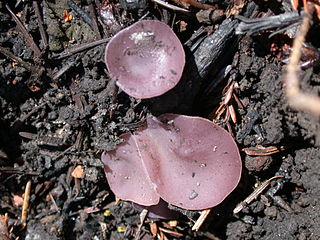
Peziza violacea, commonly known as the violet fairy cup or the violet cup fungus, is a species of fungus in the genus Peziza of the family Pezizaceae. As both it common names and specific epithet suggest, the cup-shaped fruiting bodies are violet colored on the interior surface. P. violacea is typically found growing on burnt soil.
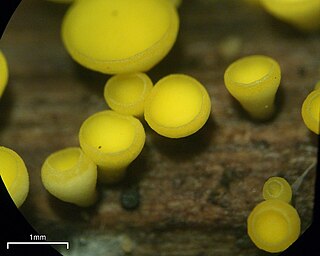
Bisporella citrina, commonly known as yellow fairy cups or lemon discos, is a species of fungus in the family Helotiaceae. The fungus produces tiny yellow cups up to 3 mm in diameter, often without stalks, that fruit in groups or dense clusters on decaying deciduous wood that has lost its bark. The widely distributed species is found in North Africa, Asia, Europe, North America, and Central and South America. Found in late summer and autumn, the fungus is fairly common, but is easily overlooked owing to its small size. There are several similar species that can in most cases be distinguished by differences in color, morphology, or substrate. Microscopically, B. citrina can be distinguished from these lookalikes by its elliptical spores, which have a central partition, and an oil drop at each end.
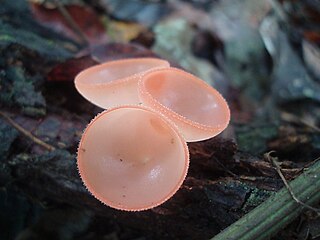
Cookeina is a genus of cup fungi in the family Sarcoscyphaceae, members of which may be found in tropical and subtropical regions of the world. Species may be found on fallen branches of angiosperms, trunks, and sometimes on fruits. The Temuans of Peninsular Malaysia are reported to use certain species from this genus as food, and also as a bait for fishing, where it is rubbed against the hook.

Geopyxis carbonaria is a species of fungus in the genus Geopyxis, family Pyronemataceae. First described to science in 1805, and given its current name in 1889, the species is commonly known as the charcoal loving elf-cup, dwarf acorn cup, stalked bonfire cup, or pixie cup. The small, goblet-shaped fruitbodies of the fungus are reddish-brown with a whitish fringe and measure up to 2 cm across. They have a short, tapered stalk. Fruitbodies are commonly found on soil where brush has recently been burned, sometimes in great numbers. The fungus is distributed throughout many temperate regions of the Northern Hemisphere. It is found in Europe, Turkey, and North America. Although it is primarily a saprotrophic species, feeding on the decomposing organic matter remaining after a fire, it also forms biotrophic associations with the roots of Norway spruce.
Limnoperdon is a fungal genus in the monotypic family Limnoperdaceae. The genus is also monotypic, as it contains a single species, the aquatic fungus Limnoperdon incarnatum. The species, described as new to science in 1976, produces fruit bodies that lack specialized structures such as a stem, cap and gills common in mushrooms. Rather, the fruit bodies—described as aquatic or floating puffballs—are small balls of loosely interwoven hyphae. The balls float on the surface of the water above submerged twigs. Experimental observations on the development of the fruit body, based on the growth on the fungus in pure culture, suggest that a thin strand of mycelium tethers the ball above water while it matures. Fruit bodies start out as a tuft of hyphae, then become cup-shaped, and eventually enclose around a single chamber that contains reddish spores. Initially discovered in a marsh in the state of Washington, the fungus has since been collected in Japan, South Africa, and Canada.
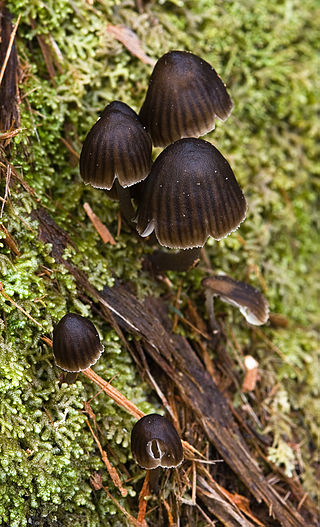
Mycena nargan, commonly known as the Nargan's bonnet, is a species of fungus in the family Mycenaceae, and the sole member of the section Nargan in the genus Mycena. Reported as a new species in 1995, it is known predominantly from Southern Australia. The saprobic fungus produces mushrooms that grow on well-decayed wood, often on the underside of wood lying in litter. The dark chestnut-coloured caps are covered with white, easily removed scales, and reach diameters of up to 2 cm (0.8 in) wide. The pale, slender stems are up to 5 cm (2.0 in) long and have white scales at the base. On the underside of the cap, the cream-coloured gills are widely spaced and bluntly attached to the stem. The edibility of the mushroom is unknown.
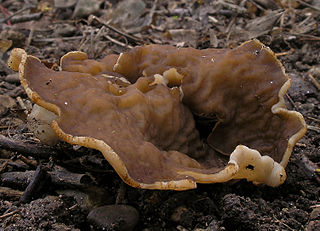
Disciotis venosa, commonly known as the bleach cup, veiny cup fungus, or the cup morel is a species of fungus in the family Morchellaceae. Fruiting in April and May, they are often difficult to locate because of their nondescript brown color. Found in North America and Europe, they appear to favor banks and slopes and sheltered sites. Although D. venosa is edible, it may resemble several other species of brown cup fungi of unknown edibility.

Plectania nannfeldtii, commonly known as Nannfeldt's Plectania, the black felt cup, or the black snowbank cup fungus, is a species of fungus in the family Sarcosomataceae. The fruit bodies of this species resemble small, black, goblet-shaped shallow cups up to 3 cm wide, with stems up to 4 cm long attached to black mycelia. Fruit bodies, which may appear alone or in groups on the ground in conifer duff, are usually attached to buried woody debris, and are commonly associated with melting snow. Plectania nannfeldtii is found in western North America and in Asia, often at higher elevations. Similar black cup fungi with which P. nannfeldtii may be confused include Pseudoplectania vogesiaca, P. nigrella, and Helvella corium.
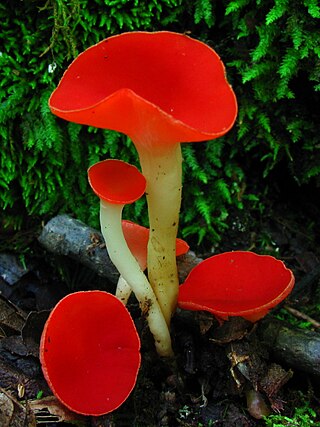
Sarcoscypha occidentalis, commonly known as the stalked scarlet cup or the western scarlet cup, is a species of fungus in the family Sarcoscyphaceae of the Pezizales order. Fruit bodies have small, bright red cups up to 2 cm (0.8 in) wide atop a slender whitish stem that is between 1 and 3 cm long. A saprobic species, it is found growing on hardwood twigs, particularly those that are partially buried in moist and shaded humus-rich soil. The fungus is distributed in the continental United States east of the Rocky Mountains, Central America, the Caribbean, and Asia. It is distinguished from the related species S. coccinea and S. austriaca by differences in geographical distribution, fruiting season, and fruit body structure. Phylogenetic analysis has shown that it is most closely related to other Sarcoscypha species that contain large oil droplets in their spores. The species Molliardiomyces occidentalis is an imperfect form of the fungus that lacks a sexually reproductive stage in its life cycle.
Clitopilus byssisedoides is a species of fungus in the family Entolomataceae. It was formally described as new to science in 2010, based on specimens found growing in a greenhouse in Botanischer Garten Jena, in Germany.

Mycena aurantiomarginata, commonly known as the golden-edge bonnet, is a species of agaric fungus in the family Mycenaceae. First formally described in 1803, it was given its current name in 1872. Widely distributed, it is common in Europe and North America, and has also been collected in North Africa, Central America, and Japan. The fungus is saprobic, and produces fruit bodies (mushrooms) that grow on the floor of coniferous forests. The mushrooms have a bell-shaped to conical cap up to 2 cm in diameter, set atop a slender stipe up to 6 cm long with yellow to orange hairs at the base. The fungus is named after its characteristic bright orange gill edges. A microscopic characteristic is the club-shaped cystidia that are covered with numerous spiky projections, resembling a mace. The edibility of the mushroom has not been determined. M. aurantiomarginata can be distinguished from similar Mycena species by differences in size, color, and substrate. A 2010 publication reported the discovery and characterization of a novel pigment named mycenaaurin A, isolated from the mushroom. The pigment is responsible for its color, and it has antibiotic activity that may function to prevent certain bacteria from growing on the mushroom.
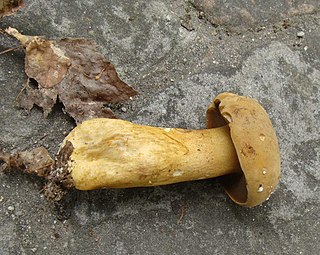
Tylopilus tabacinus is a species of bolete fungus in the family Boletaceae. It is characterized by a tawny-brown cap measuring up to 17.5 cm (6.9 in) in diameter, and a reticulated stem up to 16.5 cm (6.5 in) long by 6 cm (2.4 in) thick. A characteristic microscopic feature is the distinctive crystalline substance encrusted on the hyphae in the surface of the cap. The species is known from the eastern United States from Florida north to Rhode Island, and west to Mississippi, and from eastern Mexico. It is a mycorrhizal species, and associates with oak and beech trees.

Tricholoma vernaticum is an agaric fungus of the genus Tricholoma native to the Pacific Northwest region of the United States. The fungus was originally described in 1976 as a species of Armillaria when that genus was more inclusive; it received its current name twenty years later. The stout fruit bodies (mushrooms) have moist white to grayish caps, a membranous ring on the stipe, and an odor resembling cucumbers. Mycorrhizal with conifers, the fungus fruits in the spring or early summer, with its mushrooms appearing on the ground singly or in groups at high elevations, often at the edge of melting snowbanks. The edibility of the mushroom is unknown, but it has a strong unpleasant odor and a mealy taste.

Pholiota nubigena, commonly known as the gastroid pholiota or the bubble gum fungus, is a species of secotioid fungus in the family Strophariaceae. It is found in mountainous areas of the western United States, where it grows on rotting conifer wood, often fir logs. It fruits in spring, often under snow, and early summer toward the end of the snowmelt period in high mountain forests. Fruit bodies appear similar to unopened mushrooms, measuring 1–4 centimetres tall with 1–2.4 cm diameter caps that are whitish to brownish. They have a short but distinct whitish stipe that extend through the internal spore mass (gleba) of the fruit body into the cap. The gleba consists of irregular chambers made of contorted gills that are brownish in color. A whitish, cottony partial veil is present in young specimens, but it often disappears in age and does not leave a ring on the stipe.

Stropharia caerulea, commonly known as the blue roundhead, is a species of mushroom forming fungus in the family Strophariaceae. It is a somewhat common species found in Europe and North America, where it grows as a saprophyte in meadows, roadsides, hedgerows, gardens, and woodchip mulch. S. caerulea was officially described to science in 1979, although it was known to be a distinct species for about two centuries before that. The scientific name Stropharia cyanea, as defined by Tuomikoski in 1953, and used by several later authors, is a synonym of S. caerulea.
Scytalidium ganodermophthorum is an anthroconidial ascomycete fungus in the Scytalidium genus. It is also known by its teleomorph name Xylogone ganodermophthora. It is the cause of yellow rot in lingzhi mushrooms and it is used in spalting as a pigmenting fungi.


















